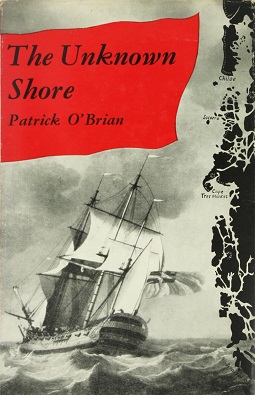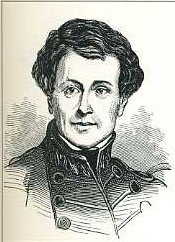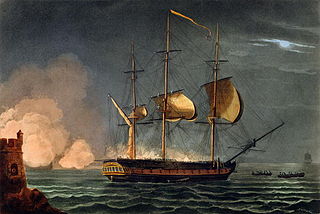
Hornblower is a series of British historical fiction war television films based on three of C. S. Forester's ten novels about the fictional character Horatio Hornblower, a Royal Navy officer during the French Revolutionary and Napoleonic Wars.

The Spithead and Nore mutinies were two major mutinies by sailors of the Royal Navy in 1797. They were the first in an increasing series of outbreaks of maritime radicalism in the Atlantic World. Despite their temporal proximity, the mutinies differed in character. The Spithead mutiny was a simple, peaceful, successful strike action to address economic grievances, while the Nore mutiny was a more radical action, articulating political ideals as well, which failed.

Rear Admiral Silas Horton Stringham was an officer of the United States Navy who saw active service during the War of 1812, the Second Barbary War, and the Mexican–American War, and who commanded the Atlantic Blockading Squadron at the beginning of the American Civil War.

Alexander Slidell MacKenzie was an officer in the United States Navy during the American Civil War.

The Unknown Shore is a novel published in 1959 by Patrick O'Brian. It is the story of two friends, Jack Byron and Tobias Barrow, who sail aboard HMS Wager as part of the voyage around the world led by Anson in 1740. Their ship did not make it all the way around the world, unlike the flagship. The novel is a fictionalised version of actual events which occurred during the Wager Mutiny.

Alexander Slidell Mackenzie, born Alexander Slidell, was a United States Navy officer, famous for his 1842 decision to execute three suspected mutineers aboard a ship under his command USS Somers in the Somers Mutiny. Mackenzie was also an accomplished man of letters, producing several volumes of travel writing and biographies of early important US naval figures, some of whom he knew personally.
Henry A. Clemson was an officer in the United States Navy in the early 19th century. Clemson died at sea during the Mexican American War (1846) and was memorialized on the Mexican War Midshipmen's Monument and the naming of a naval destroyer, USS Clemson (DD-186).

HMS Hermione was the lead ship of the Hermione-class, a six-ship class of 32-gun fifth-rate frigates of the Royal Navy. She was launched on 9 September 1782 at Bristol. Hermione was commissioned and then paid off a number of times during the 1780s. She underwent repairs between October 1790 and June 1792, followed by a period spent refitting at Chatham Dockyard until January 1793. She was recommissioned in December 1792 before sailing to the Jamaica in March 1793. Hermione served in the West Indies during the early years of the French Revolutionary Wars, participating in the British attack on Port-au-Prince, where she led a small squadron that accompanied troop transports.

Philip Spencer, a midshipman aboard USS Somers, was executed for mutiny without a court-martial, after being suspected of conspiring to kill opposing crewmembers and turn the brig into a pirate ship. He was the son of John C. Spencer, Secretary of War in U.S. President John Tyler's administration, and the grandson of Ambrose Spencer, a New York politician and lawyer.

Samuel Cromwell was a sailor and petty officer aboard the brig USS Somers. Cromwell was feared by the young apprentices who made up the majority of the ship's crew, and was rumored to have served on a slaver at one time. These rumors lent credence to the idea that he would have been amenable to Philip Spencer's alleged plot to mutiny, kill the ship's officers and such of the crew as were not wanted and sail the Somers either as a pirate ship or a slaver.

Elisha Small was an American sailor who was sailing with the rank of Seaman. He had served on several kinds of ships, including, allegedly, a slave ship, before joining the United States Navy.
Seafaring is a tradition that encompasses a variety of professions and ranks. Each of these roles carries unique responsibilities that are integral to the successful operation of a seafaring vessel. A ship's crew can generally be divided into four main categories: the deck department, the engineering department, the steward's department, and other. The reasoning behind this is that a ship's bridge, filled with sophisticated navigational equipment, requires skills differing from those used on deck operations – such as berthing, cargo and/or military devices – which in turn requires skills different from those used in a ship's engine room and propulsion, and so on.

Supply officer was a specialisation in the British Royal Navy which has recently been superseded by the Logistics Officer, recognising the need to align with the nomenclature and function of similar cadres in the British Army and Royal Air Force. Though, initially, employment of Logistics Officers in the Royal Navy remained broadly the same, it has begun to reflect exposure to the 'tri-service' environment, including a significantly greater number of operational logistics posts, as well as the more traditional Cash, Pay and Records, and 'outer-office' or Aide de Camp duties. The Logistics Branch in the Royal Navy is one of the three main branches of the Senior Service, though due to its unique nature has interaction with all branches of the Naval Service, including the Fleet Air Arm and the Royal Marines, as well as the Defence Equipment and Support Organisation, the Ministry of Defence and many other agencies and organisations. In centuries past, the supply officer had been known as the clerk, bursar, purser and, later, the paymaster. Logistics officers are still generally referred to by the historic sobriquet 'pusser', a derivation of 'purser'.
Commodore Guert Gansevoort was an officer in the United States Navy during the Mexican–American War and the American Civil War.

The Caine Mutiny is a 1952 Pulitzer Prize-winning novel by Herman Wouk. The novel grew out of Wouk's personal experiences aboard two destroyer-minesweepers in the Pacific Theater in World War II. Among its themes, it deals with the moral and ethical decisions made at sea by ship captains and other officers. The mutiny of the title is legalistic, not violent, and takes place during Typhoon Cobra, in December 1944. The court-martial that results provides the dramatic climax to the plot.

Magicienne was a frigate of the French Navy, lead ship of her class. The British captured her in 1781 and she served with the Royal Navy until her crew burned her in 1810 to prevent her capture after she grounded at Isle de France. During her service with the Royal Navy she captured several privateers and participated in the Battle of San Domingo.
Hugh Pigot was an officer in the Royal Navy. Through his connections and their patronage, he was able to rise to the rank of captain, despite apparently poor leadership skills and a reputation for brutality. Writing in 1826 William James stated, "...he has been described to us by those who knew him well, as one of the most cruel and oppressive captains belonging to the British navy." While he was captain of HMS Hermione (1782), he eventually provoked his men to mutiny. This mutiny, became the bloodiest in the history of the Royal Navy and left Pigot and nine other officers dead. The Navy hunted down and executed a number of the mutineers and recaptured his ship from the Spanish, to whom the mutineers had turned it over.
A captain's clerk was a rating, now obsolete, in the Royal Navy and the United States Navy for a person employed by the captain to keep his records, correspondence, and accounts. The regulations of the Royal Navy demanded that a purser serve at least one year as a captain's clerk, so the latter was often a young man working his way to a purser's warrant. He had high status, with an office on the quarterdeck or upper deck on most ships. He was paid at the same rate as a midshipman in 1800, but by 1815 he had almost the same monthly pay as a standing warrant officer. On large ships, he had his own cabin in the gunroom, but on smaller vessels he lived with the midshipmen on the orlop deck.

The complement of HMS Bounty, the Royal Navy ship on which a historic mutiny occurred in the south Pacific on 28 April 1789, comprised 46 men on its departure from England in December 1787 and 44 at the time of the mutiny, including her commander Lieutenant William Bligh. All but two of those aboard were Royal Navy personnel; the exceptions were two civilian botanists engaged to supervise the breadfruit plants Bounty was tasked to take from Tahiti to the West Indies. Of the 44 aboard at the time of the mutiny, 19 were set adrift in the ship's launch, while 25, a mixture of mutineers and detainees, remained on board under Fletcher Christian. Bligh led his loyalists 3,500 nautical miles to safety in the open boat, and ultimately back to England. The mutineers divided—most settled on Tahiti, where they were captured by HMS Pandora in 1791 and returned to England for trial, while Christian and eight others evaded discovery on Pitcairn Island.

The Somers Affair was an incident on board the American brig USS Somers while on a training mission in 1842 under Captain Alexander Slidell Mackenzie (1803-1848). Midshipman Philip Spencer (1823-1842) was accused of plotting a mutiny that would kill those who opposed him and then use the Somers as a very fast, well-armed pirate ship. Spencer was arrested and executed, along with two other alleged co-conspirators, Samuel Cromwell and Elisha Small, when the Somers was thirteen days away from shore. The three were hanged without a court-martial following a hastily assembled shipboard meeting. The ship then returned to New York. An inquiry and a court martial both cleared Mackenzie. There was enormous public attention, most of it unfavourable to Mackenzie.
















